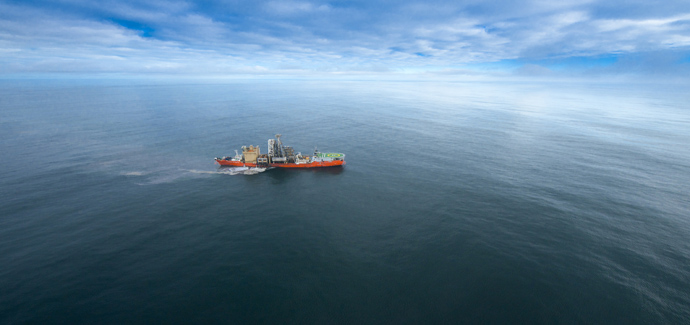Big Green Machine Sucks Up Namibian Diamonds
Huge mud-sifting machinery and other technological advances pioneered by De Beers over the past decade have enabled it to profitably exploit the world's largest marine diamond deposits in deep waters off Namibia.
A bright green crawling machine that weighs 286 tonnes and stretches over three stories tall recovers diamonds by sucking up sand and silt 100 meters and deeper underwater.
It is controlled remotely by a mining vessel called the "Mafuta" [pictured above, prior to renaming], and both are undergoing major refurbishment in Cape Town.
Offshore diamond mining started in 1961 in less than 35 meters of ocean, but it has been only in the past decade that technology has allowed operations in deeper water.
"Ten years ago a crawler would be mining at about 200 to 250 square meters an hour. Today we believe that our crawler would mine at about 1,000 square meters an hour," said Domingos Valbom, general manager of De Beers Marine.
"Mafuta" is the flagship vessel of Debmarine Namibia, a 50/50 joint venture between the Namibian government and De Beers.
De Beers Marine provides technical support and five exploration vessels for the venture's Atlantic 1 concession, which is just offshore of Oranjemund near the South African border.
The crawler uses a nozzle to slurp up tonnes of sediment an hour from ancient submerged beaches as it scours the ocean floor for diamonds carried from the Orange River to the Atlantic millions of years ago.
The prizes are big. Marine diamonds on average are of higher quality than land-based stones, because any gems with flaws are broken up by the battering they receive from the wind and waves.
"It is the best way to extract marine diamonds, but the geology in which we operate has to lend itself and the crawler has to have a surface to operate," Valbom said of the "horizontal mining" process.
When the sea bed becomes too rocky and uneven for the giant vacuum, the firm can switch to "vertical mining" by four other ships, which each use a large-diameter drill to bring diamond-bearing gravel to the surface.
Each Debmarine Namibia ship, a self-contained floating mining operation, processes the debris, and helicopters then take the 'concentrate' in jam-sized jars to land, where the diamonds are sorted by hand.
Debmarine Namibia, which bought "Mafuta" for N$650 million($60 million) last year, said at the time that the ship was expected to produce 350,000 carats a year, or about 30 percent of Debmarine production.
"The crawlers have made a step-change in our mining and to our productivity and the financial performance of marine mining," Valbom said.
He also said the company aimed to improve the efficiency of the crawler, which could be used to suck up other minerals such as gold. ($1 = 10.8400 Namibian Dollars)
By Wendell Roelf (C) Reuters 2014.

